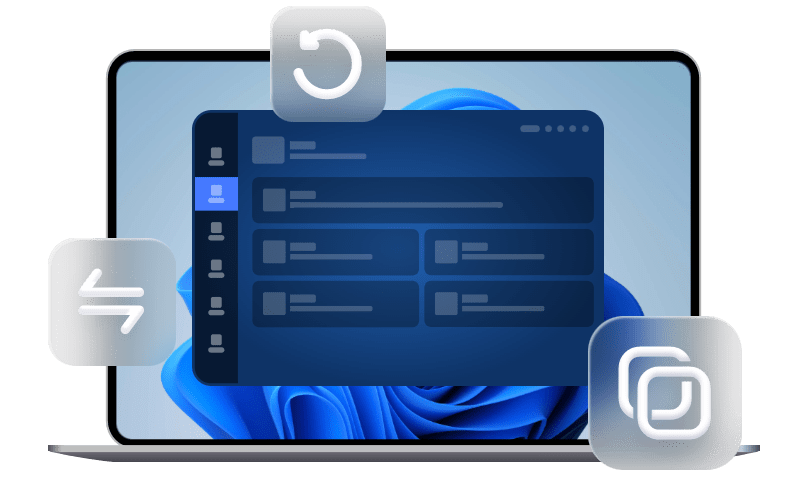Incremental and Differential Backup in Windows 11
You can learn what are incremental and differential backup in Windows 11, their difference and how to create them in Windows 11. Keep reading for more details.
What are the 3 Types of Backups?
As we all know, data backup is an important means to effectively prevent data loss. Backing up your data in advance can help you protect against the hazards caused by computer viruses, system failures or sudden shutdowns. Currently, there are 3 main backup methods, which are full backup, incremental backup and differential backup. Compared with full backups, incremental and differential backups will take less time to backup and can save as much disk space as possible.
Incremental backup means that after one full backup or the incremental backup, each subsequent backup task only backs up files that have been added or modified compared to the previous one. A differential backup, on the other hand, will backup files that have been modified since the last full backup.
Incremental vs Differential Backup in Windows 11
Both incremental and differential backup are widely applicable backup method, which backs up only newly added and changed items to save much backup time and space. However, in view of different basis, there are some differences.
- Backup speed: Incremental backups will take longer for the first backup, and each subsequent backup will get faster and faster. Differential backups, on the other hand, are slower with each backup.
- Occupied disk space: Since differential tasks back up more data than incremental backups, differential backups occupy more disk space than incremental backups.
- Restore requirements and speed: Incremental backups require a full backup and all linked incremental backups. And incremental backups are quite slow to restore. While a differential backup requires a full backup and any one of the differential backups, preferably the latest one with the differential backup file. And the restore speed is much faster.
In general, the biggest advantage of incremental backups is that they take less time to backup and are faster. Differential backups, on the other hand, have the biggest advantage of their integrity and independence, which increases the speed and success rate of restore. You can choose the appropriate backup method for your own needs.
How to Perform Incremental and Differential Backup in Windows 11
Whether you want to create incremental or differential backups, the safe and reliable third-party backup software AOMEI Backupper Professional is a great choice. It provides 4 backup solutions, namely System Backup, Disk Backup, File Backup and Partition Backup to protect your data in all aspects.
- 3 backup methods: It offers Full backup, Incremental and Differential backup. Therefore, you can choose anyone of them according to your own needs.
- Scheduled backup: You can perform a scheduled backup with fixed intervals such as Daily, Weekly, Monthly, Event trigger and USB plug in. The software will automatically perform backups for you at regular intervals based on the frequency you set.
- Automatic backup cleanup: This feature helps you regularly and automatically remove older backups to save disk space.
- Multiple systems: It supports multiple Windows operating systems, including Windows 11, 10, 8.1, 8, 7, XP, Vista, etc.
Before you start, please download this software. If you are a Windows Server user, then AOMEI Backupper Server is more suitable for you. You can follow the graphic tutorial below to start learning how to make incremental backups or differential backups. Here is an example of file backup.
Step 1. Firstly, open this backup software, and select Backup > File Backup.
Step 2. Then you can click Add File or Add Folder to select the files or folders to be backed up.
Step 3. You need to select a destination location to store your file backup.
Step 4. At this point, you have 2 ways to do backups. You can choose to schedule a backup and then set the backup frequency and the software will automatically back up your files for you. Or you can choose to back up your files manually after the software has done a full backup.
Step 5. Then click Backup Scheme at the lower location and then select incremental or differential backup under the Backup Method.
- Note:✎...
- Even if the incremental and differential backups only backup the changed parts, the disk space will be filled up one day as more and more backups are made. Don't worry, you can enable automatic backup cleanup feature, which will regularly clean up the extra backup files for you to save disk space.
Step 6. Confirm all your operations and click Start Backup to backup files.
- Notes:✎...
- Options: You can write comments to distinguish the backup tasks, compress or split the backup image file as well as enable email notification.
- Schedule Backup: This software allows you to backup files with fixed intervals, including Daily, Weekly, Monthly, Event trigger and USB plug in.
- Backup Scheme: You can choose different backup methods. To help you save disk space by deleting older backups, you can enable automatic backup cleanup feature.
Summary
Professional backup software AOMEI Backupper Professional can help you backup your system, disks, partitions and files easily. It supports full backup, incremental backup and differential backup, you can choose any one of them according to your own needs. And you can set different frequency to backup files automatically. It also supports multiple Windows systems.
Besides, it is also an excellent restore software that can quickly help you restore incremental backups or differential backups. If you want to restore a system backup to a computer with different hardware, you can use its Universal Restore feature to achieve the goal. You can download this software to discover more useful features.

